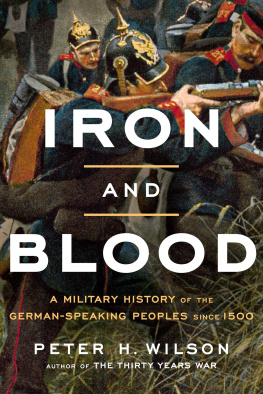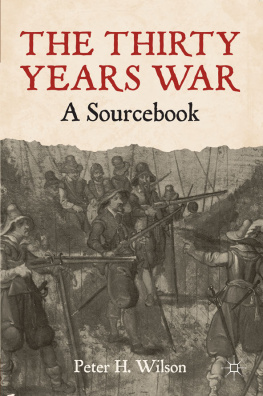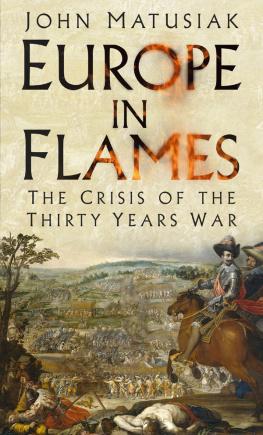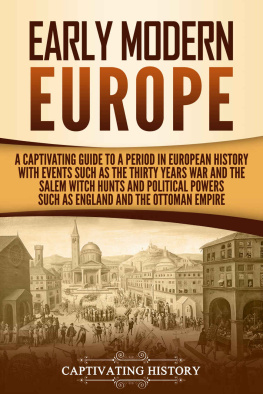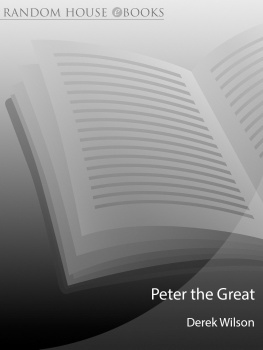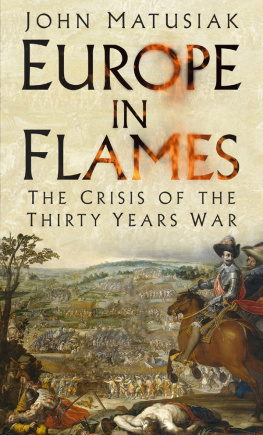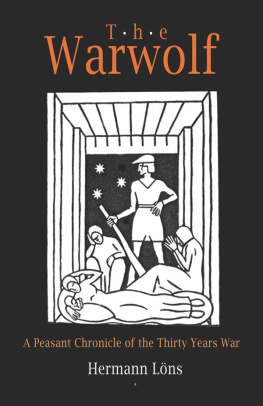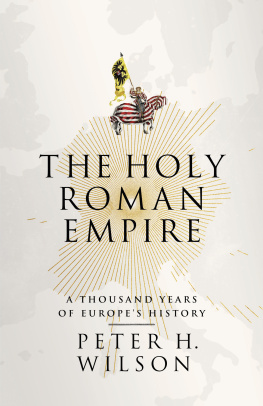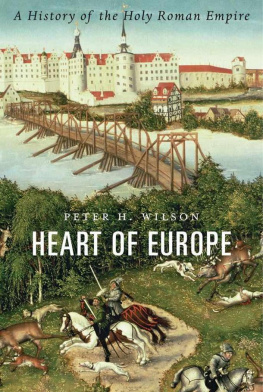PETERH . WILSON
Europes Tragedy
A History of the Thirty Years War

ALLEN LANE
an imprint of
PENGUIN BOOKS
ALLEN LANE
Published by the Penguin Group
Penguin Books Ltd, 80 Strand, London WC2R 0RL , England
Penguin Group (USA) Inc., 375 Hudson Street, New York, New York 10014, USA
Penguin Group (Canada), 90 Eglinton Avenue East, Suite 700, Toronto, Ontario, Canada M4P 2Y3
(a division of Pearson Penguin Canada Inc.)
Penguin Ireland, 25 St Stephens Green, Dublin 2, Ireland
(a division of Penguin Books Ltd)
Penguin Group (Australia), 250 Camberwell Road, Camberwell, Victoria 3124, Australia
(a division of Pearson Australia Group Pty Ltd)
Penguin Books India Pvt Ltd, 11 Community Centre, Panchsheel Park, New Delhi 110 017, India
Penguin Group (NZ), 67 Apollo Drive, Rosedale, North Shore 0632, New Zealand
(a division of Pearson New Zealand Ltd)
Penguin Books (South Africa) (Pty) Ltd, 24 Sturdee Avenue, Rosebank, Johannesburg 2196, South Africa
Penguin Books Ltd, Registered Offices: 80 Strand, London WC2R 0RL , England
www.penguin.com
First published 2009
Copyright Peter H. Wilson, 2009
The moral right of the author has been asserted
The endpaper map was originally drawn by Reginald Piggott for a reissue of C. V. Wedgwoods
The Thirty Years War (1938) and retains a handful of variant place-name spellings.
It is reproduced courtesy of the Folio Society.
All rights reserved.
Without limiting the rights under copyright reserved above, no part of this publication may be reproduced, stored in or introduced into a retrieval system, or transmitted, in any form or by any means (electronic, mechanical, photocopying, recording or otherwise) without the prior written permission of both the copyright owner and the above publisher of this book
A CIP catalogue record for this book is available from the British Library
ISBN: 978-0-14-193780-9
For my family
Contents
List of Illustrations
Photographic acknowledgements are given in parentheses. Every effort has been made to contact all copyright holders. The Publishers will be happy to make good in future editions of this book any errors or omissions brought to their attention.
(detail), 1632, by Jan Asselijn (Herzog Anton Ulrich-Museum, Brunswick; photogrpah courtesy akg-images/ullstein bild)
List of Maps and Battle Plans
Maps
Battle Plans
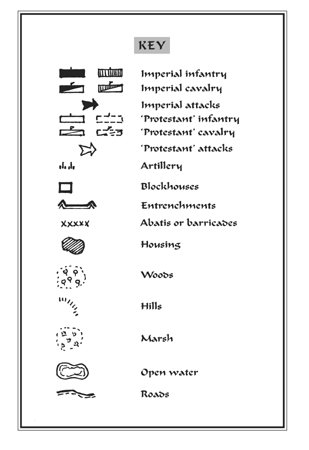
List of Tables
Note on Form
Place names are given in the form most commonly used in English-language writing. For east Central European locations, this tends to be the German version. The current name is given in parenthesis at the first mention. Individuals are identified in the text using their first name and the title by which they are best known. Full names and titles, along with dates of birth and death (where known) are given for each person in the index. Emperor Ferdinand IIs general has become known as Wallenstein since Schillers drama trilogy at the end of the eighteenth century. This version has entrenched itself in English writing and will be used here rather than the Czech original, Waldstein. In contemporary documents, he generally appears as the Friedlnder after his duchy of Friedland. Though anachronistic, the term Britain will be used for the lands of the Stuart monarchy in preference to the still more misleading England, unless it is intended to refer to the individual kingdoms or principalities. All dates are given in the New Style according to the Gregorian calendar introduced into the Catholic parts of Europe and the Holy Roman Empire around 1582. This was ten days ahead of the Julian calendar retained by Protestant Germans generally until 1700.
The Habsburg Family Tree 15001665
Note on Currencies
Currency | Equivalent |
Escudo (Spain) | 1.1 ducats (Spain, from 1620), or 2.5 fl. (Dutch) |
Ducat (Spain) | 2.35 fl. (Dutch), or 1.4 fl. (German) |
Ducat (Naples) | 0.7 ducat (Spain) |
Florin (German) | 1.7 fl. (Dutch) |
Livre (French) | initially 0.7 fl. (German); 0.5 fl. after 1640 |
Pound sterling | 4.24.8 talers |
Riksdaler (Denmark/Sweden) | 11.5 fl. (German) |
Taler (Empire) | 1.5 fl. (German), or 2.5 fl. (Dutch) |
It is difficult to give modern equivalents to seventeenth-century currency. As a guide to value, 7.510 florins would buy enough grain to feed a person for a whole year in 1618.
Preface
The history of the Thirty Years War is rich in specialist studies, but poor in general accounts. Few authors provide more than short overviews intended for students. It is easy to see why. To cover all aspects would require knowledge of at least fourteen European languages, while there are sufficient archival records to occupy many lifetimes of research. Even the printed material runs to millions of pages; there are over 4,000 titles just on the Peace of Westphalia that concluded the conflict. The sheer volume of evidence has affected how previous histories have been written. Some cut through the detail by fitting the war into broader explanations of Europes transition to modernity. Others give more scope to personalities and events but often signs of fatigue set in as the author approaches the mid-1630s. By then the heroes and villains giving life to the opening phases were largely dead, replaced by other figures ignored by posterity. There is a rush to wrap up the story and the last thirteen years are compressed into a quarter or less of the text, much of which is devoted to discussing the peace and aftermath.
The present work seeks to redress this through a more even coverage across the entire time span. Some of the distinctive features of this approach are set out in the introductory chapter. The most important is to view the war on its own terms as a struggle over the political and religious order of Central Europe, rather than submerging it within a general account of European conflict throughout the first half of the seventeenth century. While this simplifies some aspects, it also directs attention to the wars origins in the complex situation in the Holy Roman Empire during the later sixteenth century. The task of the first part of the book is to explain this and place it in the wider European context. The second part follows the unfolding tragedy roughly chronologically, paying particular regard to why peace-making efforts failed before the mid-1640s. The final part examines the wars political, economic, social and cultural impact and longer-term significance. Throughout, structural explanations have been combined with an emphasis on agency and contingency, giving more space than customary to minor as well as more prominent participants. Referencing is selective, excluding much of the older material used in favour of recent works that are more accessible for most readers and provide a useful guide to the specialist literature.
It is a great pleasure to acknowledge the support of the Arts and Humanities Research Council for a Research Leave Award in 20078 that enabled this book to be completed. I have also benefited from a supportive research environment during my time at the University of Sunderland, as well as a warm welcome by the History Department at Hull where the final sections were written. Leopold Auer and the staff of the Haus-, Hof- und Staatsarchiv Vienna provided valuable assistance during my all-too-brief visit in 2006. I am grateful to Scott Dixon, Robert Evans, Ralph Morrison and Neil Rennoldson for their help in locating obscure works, and especially to Kacper Rekawek for assisting with Polish-language material. Clarissa Campbell Orr, Tryntje Helfferich, Michael Kaiser, Maureen Meikle, Gza Plffy and Ciro Paoletti all generously shared their knowledge on numerous points of detail. I am particularly indebted to Trevor Johnson for providing a pre-publication version of his book on Bavarian policy. Sadly, his sudden death in 2007 means I am no longer able to reciprocate.
Next page

